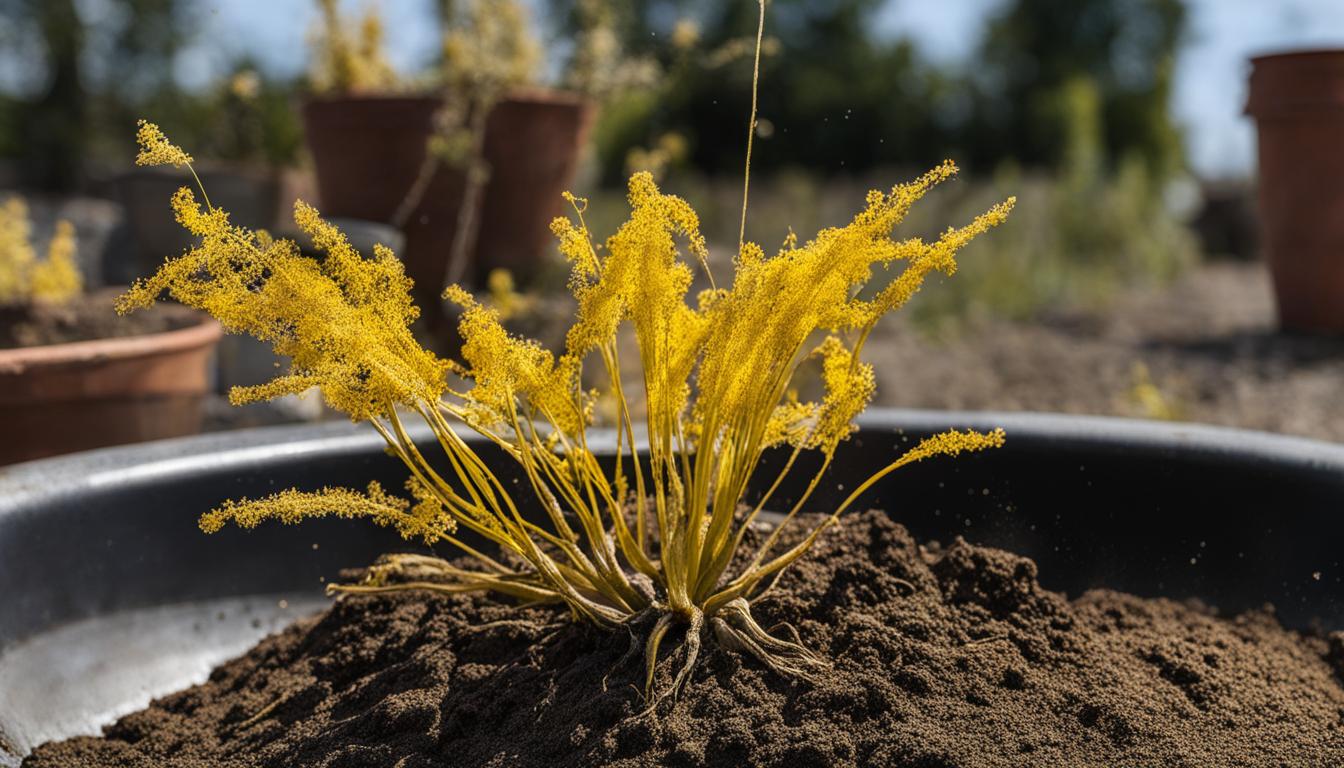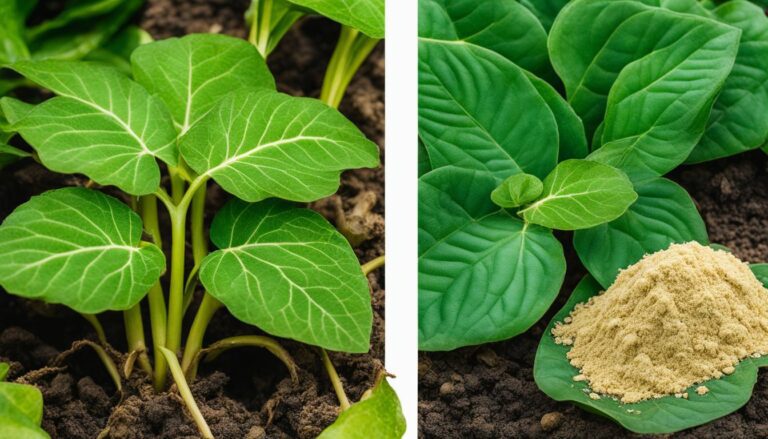
Sulfur is an essential element for successful crop production, playing a significant role in plant physiology and protection from stress and pests.
It is necessary for protein synthesis and chlorophyll production, which is crucial for photosynthesis. Sulfur is considered a secondary macronutrient, but it is still important for healthy crops and increased yields.
However, sulfur availability in soil has declined in recent years due to environmental changes and agricultural practices. This decline has led to an increase in sulfur deficiency in crops.
In this section, we will discuss the sources of available sulfur for crops, the factors contributing to the decline in sulfur availability, and how to recognize and correct sulfur deficiencies in various crops.
Key Takeaways:
- Plant sulfur deficiency can negatively impact crop production and yield.
- Sulfur availability in soil has declined due to environmental changes and agricultural practices.
- Recognizing sulfur deficiency symptoms in plants is crucial for timely treatment.
- Sulfur-containing fertilizers and organic sources can help correct sulfur deficiencies.
- Sulfur plays a critical role in protein synthesis, chlorophyll production, and overall plant development.
Sources of Sulfur for Crops
Sulfur, an essential element for successful crop production, has seen a decline in availability in recent years. This decline can be attributed to various factors, including changes in agricultural practices and decreased atmospheric deposition due to air pollution controls. As a result, farmers need to explore alternative sources of sulfur for their crops.
Organic matter, such as compost and crop residues, can be a valuable source of sulfur. Incorporating organic matter into the soil not only improves soil fertility but also increases sulfur availability.
Manure from livestock operations is another excellent source of sulfur. Applying manure to fields can provide crops with the necessary sulfur while also improving soil structure and nutrient content.
Fertilizers are another option for supplying sulfur to crops. Sulfur-containing fertilizers, such as ammonium sulfate and ammonium thiosulfate, are commonly used to correct sulfur deficiencies.
These fertilizers provide both sulfur and nitrogen, ensuring that crops have access to both essential nutrients. Additionally, elemental sulfur and gypsum can be used as soil amendments to increase sulfur availability.
It is important for farmers to assess their soil conditions and nutrient requirements to determine the most appropriate source of sulfur for their crops. By carefully selecting and applying sulfur sources, farmers can effectively address sulfur deficiencies and promote healthy crop growth.
| Source | Advantages | Disadvantages |
|---|---|---|
| Organic Matter | – Increases sulfur availability – Improves soil fertility | – Slow release of sulfur – May require large amounts for significant impact |
| Manure | – Provides sulfur and other nutrients – Improves soil structure | – Requires availability of livestock manure – Requires proper application to avoid nutrient imbalances |
| Fertilizers | – Instant supply of sulfur – Can be tailored to specific nutrient requirements | – Requires careful application to prevent over-fertilization – Cost associated with purchasing and applying fertilizers |
| Elemental Sulfur | – Increases sulfur availability over time – Can improve soil pH | – Slow release of sulfur – Requires microbial activity for conversion to plant-available form |
Identifying and Diagnosing Sulfur Deficiency
Sulfur deficiency in plants can have detrimental effects on their growth and overall health. It is essential to be able to identify and diagnose sulfur deficiency in order to take appropriate action.
By recognizing the symptoms of sulfur deficiency, farmers and growers can address the issue and ensure their crops receive the necessary nutrients for optimal growth.
Symptoms of Sulfur Deficiency
The most common symptom of sulfur deficiency is yellowing of the leaves, particularly in the younger leaves. Unlike nitrogen deficiency, which affects older leaves first, sulfur deficiency primarily affects the new growth.
Other symptoms include interveinal striping, slow growth, delayed leaf maturity, and thinning stems. It is important to note that sulfur deficiency symptoms may not be uniform and can appear in spots or streaks within a field, especially in areas with colder or wetter soil conditions.
Diagnosing Sulfur Deficiency
Identifying sulfur deficiency can be challenging, as the symptoms can overlap with those of other nutrient deficiencies or conditions. The most accurate way to diagnose sulfur deficiency is through a plant tissue analysis.
This analysis provides precise information on the nutrient levels within the plant, allowing for targeted corrective measures. Plant tissue analyses are conducted by taking samples of the plant’s leaves, stems, or roots and sending them to a laboratory for testing.
The results can then guide farmers in determining the appropriate course of action to address sulfur deficiency in their crops.
By understanding and being able to identify the symptoms of sulfur deficiency and utilizing plant tissue analysis for accurate diagnosis, farmers can effectively address sulfur deficiency in their crops.
Taking timely action can help ensure that plants receive the necessary sulfur for optimal growth, leading to healthier and more productive crops.
Correcting Sulfur Deficiency
When it comes to addressing sulfur deficiency in plants, there are several effective methods to consider. One option is to use sulfur-containing fertilizers such as ammonium sulfate or ammonium thiosulfate.
These fertilizers not only provide sulfur but also contribute to nitrogen levels, giving crops a much-needed boost. Another alternative is elemental sulfur, which can be added to fertilizer mixes to address sulfur deficiency.
Gypsum, a soil amendment containing calcium sulfate, is a cost-effective solution for soils deficient in both calcium and sulfur.
By using gypsum, farmers can address two nutrient deficiencies in one application, improving overall soil health. Manure can serve as a valuable source of sulfur for crops, especially when applied in the appropriate amounts and at the right time.
The Benefits of Different Sulfur Correction Methods
The choice of sulfur correction method depends on various factors, including soil conditions and the presence of other nutrient deficiencies. Here is a breakdown of the benefits associated with different sulfur correction methods:
- Ammonium sulfate and ammonium thiosulfate fertilizers provide sulfur and nitrogen, addressing multiple nutrient deficiencies simultaneously.
- Elemental sulfur allows for targeted sulfur supplementation, making it ideal for addressing specific deficiencies.
- Gypsum not only provides sulfur but also helps improve soil structure and water infiltration, enhancing overall soil health.
- Manure, when applied correctly, can serve as an organic source of sulfur, promoting sustainable farming practices.
By understanding the various sulfur correction methods available and their specific benefits, farmers can make informed decisions to address sulfur deficiency in their crops effectively.
It is recommended to consult with agronomists or agricultural experts to determine the best approach based on individual soil conditions and crop requirements.
| Sulfur Correction Method | Benefits |
|---|---|
| Ammonium sulfate and ammonium thiosulfate fertilizers | Provides sulfur and nitrogen simultaneously |
| Elemental sulfur | Allows for targeted sulfur supplementation |
| Gypsum | Improves soil structure and water infiltration |
| Manure | Organic source of sulfur, promotes sustainable farming practices |
Importance of Sulfur in Crop Nutrition Programs
Sulfur is a vital element in crop nutrition programs, playing a crucial role in achieving optimal plant development and increasing crop yield.
With the ever-growing demand for higher yields, it has become even more important to understand the significance of sulfur in maintaining healthy crops.
As part of plant nutrition, sulfur is closely linked to nitrogen. It is essential for protein synthesis, chlorophyll production, and the conversion of nitrates into amino acids.
By providing sulfur to crops, we ensure that they have the necessary building blocks for growth and development.
There are various methods for applying sulfur to crops, each with its own advantages. One effective method is in-furrow sulfur application during planting.
By incorporating sulfur directly into the soil near the seed, we ensure that young plants have immediate access to this essential nutrient.
Another approach is to combine sulfur with nitrogen fertilizers. This not only provides sulfur to crops but also optimizes the effectiveness of nutrient programs by addressing multiple nutrient requirements simultaneously.
By carefully considering the sulfur demands of specific crops, farmers can choose the most suitable application method to maximize crop yield.
FAQ
How do I identify sulfur deficiency in my plants?
Sulfur deficiency in plants can be recognized through symptoms such as yellowing of the leaves, interveinal striping, slow growth, delayed leaf maturity, and thinning stems. These symptoms may not be uniform across fields and can appear in spots or streaks.
What are the sources of sulfur for crops?
Sources of sulfur for crops include organic matter, manure, and fertilizers. Atmospheric deposition, which used to provide sulfur, has decreased due to air pollution controls.
How can I correct sulfur deficiency in my plants?
Sulfur deficiency in plants can be corrected by using sulfur-containing fertilizers such as ammonium sulfate or ammonium thiosulfate. Elemental sulfur and gypsum, a soil amendment containing calcium sulfate, can also be used. Manure can be a valuable source of sulfur as well.
Why is sulfur important in crop nutrition programs?
Sulfur plays a crucial role in crop nutrition programs as it is necessary for protein synthesis and chlorophyll production, which are essential for photosynthesis. It is closely associated with nitrogen demand in crops and is important for optimal plant development.
How should sulfur be applied to crops?
Sulfur can be applied to crops through various methods, including in-furrow application during planting and combining it with nitrogen fertilizers. These methods ensure that sulfur is readily available to plants and can improve the overall effectiveness of nutrient programs.






